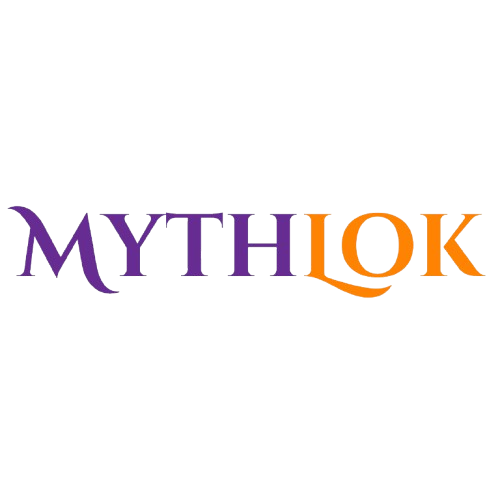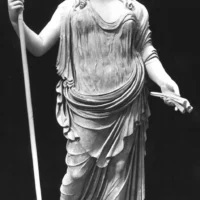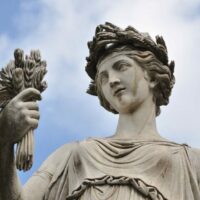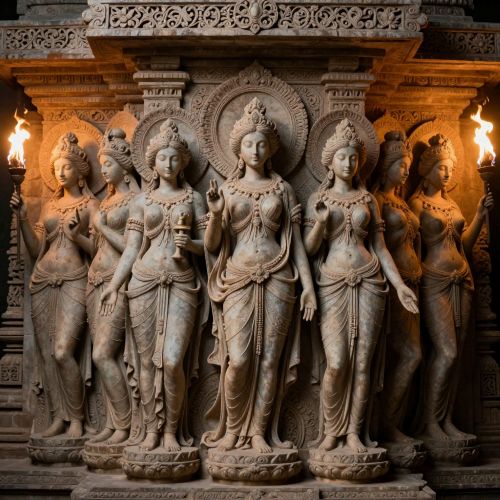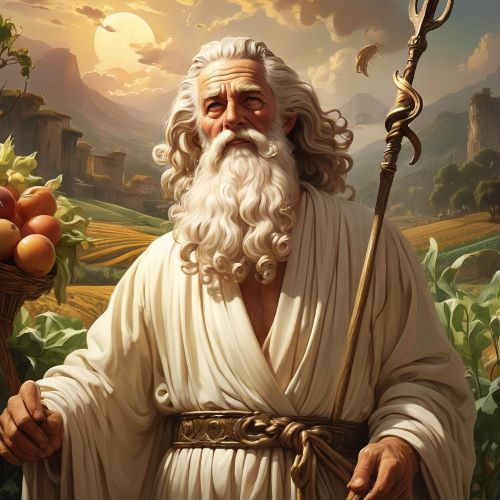Ceres : Goddess of Agriculture
Listen
Ceres
Introduction
In Roman mythology, Ceres is a prominent deity associated with agriculture, grain, and fertility, symbolizing the cycles of life, growth, and the bounty of nature. The ancient Romans revered her as essential to their sustenance and well-being, encompassing both the practical aspects of agriculture and the spiritual dimensions of nature’s cycles. Ceres’ mythology intersects with the Greek goddess Demeter, reflecting common themes of fertility and agriculture in ancient Mediterranean religions. She held a position of paramount importance in the Roman pantheon, embodying the nurturing spirit of the earth and ensuring bountiful harvests and abundant crops. Her influence extended beyond farming, touching upon the core values of family, sustenance, and the cyclical nature of life and death.
Physical Traits
Ceres is often depicted in classical art with attributes that symbolize her divine connection to agriculture and fertility. She is commonly shown wearing a flowing robe, symbolizing her relationship with nature and the harvest. In her hands, she might hold a sheaf of wheat or a cornucopia, representing abundance and the fruits of the earth. Her crown or garland of wheat further emphasizes her role as the goddess of grain and the harvest. Ceres is portrayed as a mature, motherly figure, embodying the nurturing aspect of agriculture, with a serene and dignified appearance that reflects her role as a benevolent goddess.
The imagery surrounding Ceres evokes a sense of abundance and prosperity from a successful harvest. Artists often depict her as a woman of stature, her presence commanding respect and reverence. Her serene countenance reflects her role as the caretaker of the land, and she is often shown holding a sickle, symbolizing the harvest, surrounded by shafts of grain to capture her connection to agriculture and the cycle of life.
Family
Ceres hails from a divine lineage as the daughter of Saturn, the god of time, and Ops, the goddess of abundance. Her siblings include Jupiter, Neptune, Juno, and Vesta, each playing significant roles in the Roman pantheon. Of particular relevance to Ceres’ mythology is her daughter, Proserpina, the goddess of spring and vegetation. Their story, involving Proserpina’s abduction to the underworld, is central to Ceres’ mythology and has profound implications for the cycle of the seasons.
Ceres’ family connections emphasize her importance in Roman religious life. She is a member of the Olympian family of deities and a key figure within the larger pantheon. She is also the mother of Proserpina, whom she had with Jupiter. The myth of Proserpina’s abduction by Pluto and her annual return to her mother is a central theme in Ceres’ mythology, reflecting themes of seasonal change and agricultural cycles. This myth explains the variation in crop growth and fertility throughout the year, illustrating the deep connection between Ceres, her daughter, and the natural world.
Other names
Ceres, the primary name of the Roman goddess of agriculture and fertility, also bore several titles reflecting her diverse roles. As Dea Matrona, she was honored as a maternal figure, embodying protection and nourishment for her people. The title Tellus Mater highlighted her connection to the fertile earth, representing the sustenance provided by the land. Additionally, Consus referred to the hidden or stored grain, underscoring the importance of preserving crops for future use.
Ceres’ influence extended beyond Roman tradition, closely aligning with the Greek goddess Demeter. The Romans adapted Greek myths, making Ceres the Roman counterpart to Demeter, and her name, derived from the Latin word for “grain,” emphasized her role in nourishment and life. Although Ceres is primarily recognized in Roman contexts, her mythology intersects with Demeter’s Greek stories. Moreover, Ceres was linked to other deities and aspects of fertility, such as Tellus (Terra), broadening her role to encompass the earth’s overall fertility and abundance.
Powers and Abilities
Ceres wielded a range of powers linked to her domain over agriculture and fertility. She had the ability to control the growth of plants, influencing their germination, development, and harvest. Her blessings extended beyond crops, impacting human fertility and community prosperity. As a nurturing figure, she was also associated with healing and restoration, both physically and spiritually. Her control over natural elements like rain and sunshine further supported agricultural productivity.
Ceres’ connection to the underworld, through the myth of her daughter Proserpina’s abduction, highlights her role in the cycles of life and death. This myth reflects Ceres’ influence over agricultural fertility and the direct correlation between her emotional state and the land’s productivity. Her grief over Proserpina’s abduction caused the earth to become barren, demonstrating her significant impact on the land. Her eventual reunion with Proserpina symbolizes the return of fertility and the cyclical renewal of life, emphasizing her role in the seasonal rhythms of agriculture.
Modern Day Influence
Ceres’ influence persists in modern culture through various sectors related to agriculture and symbolism. The term “cereal,” derived from her name, highlights her lasting connection to grains and essential food products. Her mythology continues to inspire literature and popular culture, often used to explore themes of nature, fertility, and environmental balance. Ceres is also depicted in art, from classical sculptures to contemporary media, representing the ongoing relationship between humanity and the earth. In astronomy, the dwarf planet Ceres, discovered in 1801 and located in the asteroid belt, commemorates her association with harvest and nature’s bounty.
The legacy of Ceres is evident in modern agricultural practices, where the importance of sustaining crops reflects her role as the goddess of harvest. The concept of nurturing motherhood echoes her maternal qualities, and although fertility rituals have evolved, their roots can be traced back to her worship. Environmentalism today resonates with the reverence Ceres inspired for nature, while her image, often associated with abundance, remains a potent symbol of prosperity.
Related Images
Frequently Asked Questions
What is lorem Ipsum?
I am text block. Click edit button to change this text. Lorem ipsum dolor sit amet, consectetur adipiscing elit. Ut elit tellus, luctus nec ullamcorper mattis, pulvinar dapibus leo.
What is lorem Ipsum?
I am text block. Click edit button to change this text. Lorem ipsum dolor sit amet, consectetur adipiscing elit. Ut elit tellus, luctus nec ullamcorper mattis, pulvinar dapibus leo.
What is lorem Ipsum?
I am text block. Click edit button to change this text. Lorem ipsum dolor sit amet, consectetur adipiscing elit. Ut elit tellus, luctus nec ullamcorper mattis, pulvinar dapibus leo.
What is lorem Ipsum?
I am text block. Click edit button to change this text. Lorem ipsum dolor sit amet, consectetur adipiscing elit. Ut elit tellus, luctus nec ullamcorper mattis, pulvinar dapibus leo.
What is lorem Ipsum?
I am text block. Click edit button to change this text. Lorem ipsum dolor sit amet, consectetur adipiscing elit. Ut elit tellus, luctus nec ullamcorper mattis, pulvinar dapibus leo.

